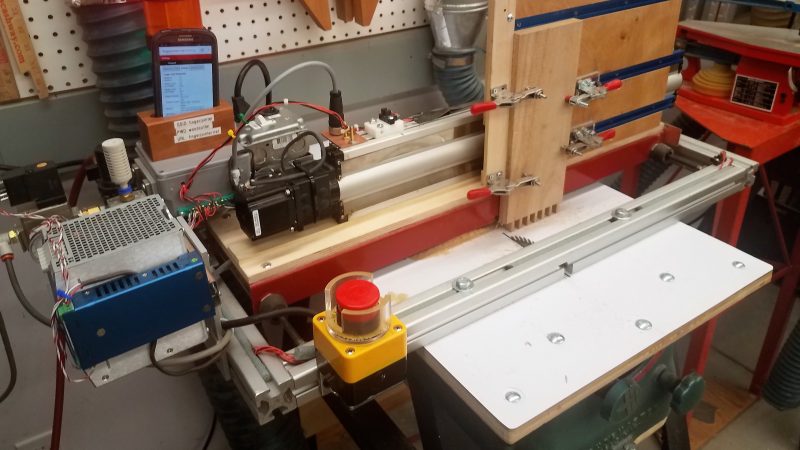We’ve all seen finger joints or box joints, those interlocking puzzle pieces that make laser-cut plywood enclosures such a fixture for DIY projects. But laser cutters make finger joints look much easier to fabricate than they are with traditional woodworking tools, which often lead to disappointing results.
But this finger joint cutting robot is no traditional woodworking tool, and [timschefter] put a lot of work into building the rig. We have to admit that when we first saw the video below, the thought of having a table saw in our shop that could be turned on with a button on a phone gave us pause. But on closer analysis, it looks like safety was a major concern with this build. With a prominent e-stop and an interlock switch, the small table saw that forms the foundation of the robot should be safe enough. On the table top is a sled with a linear slide that moves the workpiece perpendicular to the blade, and the sled moves back and forth over the blade with pneumatic cylinders. The joint is set up with a custom app which calculates the pin width and spacing, which can be evenly distributed across the panel, or, for a bit of geeky fun, controlled to make a joint that encodes a message in Morse.
A lot of work went into this, and while it’s not the first robotic finger joint cutter we’ve seen, it’s pretty impressive. Now if it could only automate dovetails.
[wpvideo essp7TNU]
















If you built a similar system with a router and a dovetail bit, you could automate the dovetails. They already make dovetail jigs for routers. I have managed to hidden dovetails in the past using a router, it takes a bit of work but its completely doable.
Dovetails look nice, but with modern glue, straight finger joints are just as strong. When done right, the wood breaks and not the joint. Dovetail joints were preferred at the time when glue wasn’t very good.
Gawd…that video doesn’t fit on my screen… I think it’s high time that:
* New phones came with “square” CCDs… so they can crop the video image to being in landscape format
* Existing phones refuse to take videos unless the phone is in a landscape orientation
try this link:
https://videopress.com/embed/essp7TNU?hd=0&autoPlay=1
Auto rotating camera to force landscape, hah
The resolution of the existing sensors is so high that you dont need a square ccd, there are enough pixels on phones to get even 4k in either landscape or portrait orientation of the sensor.
https://www.youtube.com/watch?v=Bt9zSfinwFA
It’s funny to look at the first of television around a century ago, there were a few in vertical orientation, as a face was all they could do.
A lot of those did without fancy electronic scanning, instead using a spinning disc to move the dot around. 1080 lines? 720 lines? 525 lines? Pah… these barely did 30 lines!
I’m quite happy with the swivel function of my monitor…
Sadly, Panasonic didn’t include a swivel function on my laptop.
My brain read that as robotic table saw automates cutting fingers. Had to read it twice.
+1
I think there’s a jigsaw older than me at home that has that feature too.
Too bad not even a short major BOM, skipping the code posting I can understand, but a bit of detail on the parts used would be nice
But can it do https://www.youtube.com/watch?v=Qv0VEN105nI ?
I totally love that industrial music during the video. Just that probably worth building the whole project IMO
Really awesome project Dan. Well done!!!
It’s one of those lost causes, as these are widely referred to as “finger joints”, but I prefer the (also widely-used) term “box joint”.
This article is about what I would call a “finger joint”: https://www.canadianwoodworking.com/tipstechniques/finger-joint
As an engineer, I’m not impressed by that e-stop button. What’s the purpose of using one if it’s protected by a plastic surrounding…